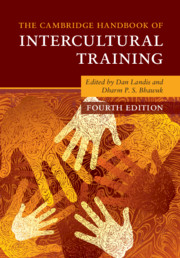Book contents
- The Cambridge Handbook of Intercultural Training
- Reviews
- The Cambridge Handbook of Intercultural Training
- Copyright page
- Dedication
- Frontispiece
- Contents
- Figures
- Tables
- Editors and Contributors
- Foreword
- Preface
- 1 Introduction and Theoretical Framework
- Part I Theoretical Foundations of Intercultural Training
- Part II Practice of Intercultural Training
- Part III Indigenous Psychology and Intercultural Training
- Part IV New Interdisciplinary Approaches to Intercultural Training
- Part V Summing Up
- Index
- References
1 - Introduction and Theoretical Framework
Published online by Cambridge University Press: 18 September 2020
- The Cambridge Handbook of Intercultural Training
- Reviews
- The Cambridge Handbook of Intercultural Training
- Copyright page
- Dedication
- Frontispiece
- Contents
- Figures
- Tables
- Editors and Contributors
- Foreword
- Preface
- 1 Introduction and Theoretical Framework
- Part I Theoretical Foundations of Intercultural Training
- Part II Practice of Intercultural Training
- Part III Indigenous Psychology and Intercultural Training
- Part IV New Interdisciplinary Approaches to Intercultural Training
- Part V Summing Up
- Index
- References
Summary
This chapter provides a rationale for this 4th Edition of the Handbook of Intercultural Training. This rationale is situated within a consideration of the impacts of inter-and intra-reginal migration and the impacts on sustainability of broad swathes of the planet. Following that discussion we will present some of the major theories of intercultural training. Lastly we will discuss the structure of the book and provide brief summaries of each chapter.
- Type
- Chapter
- Information
- The Cambridge Handbook of Intercultural Training , pp. 1 - 36Publisher: Cambridge University PressPrint publication year: 2020
References
- 2
- Cited by



